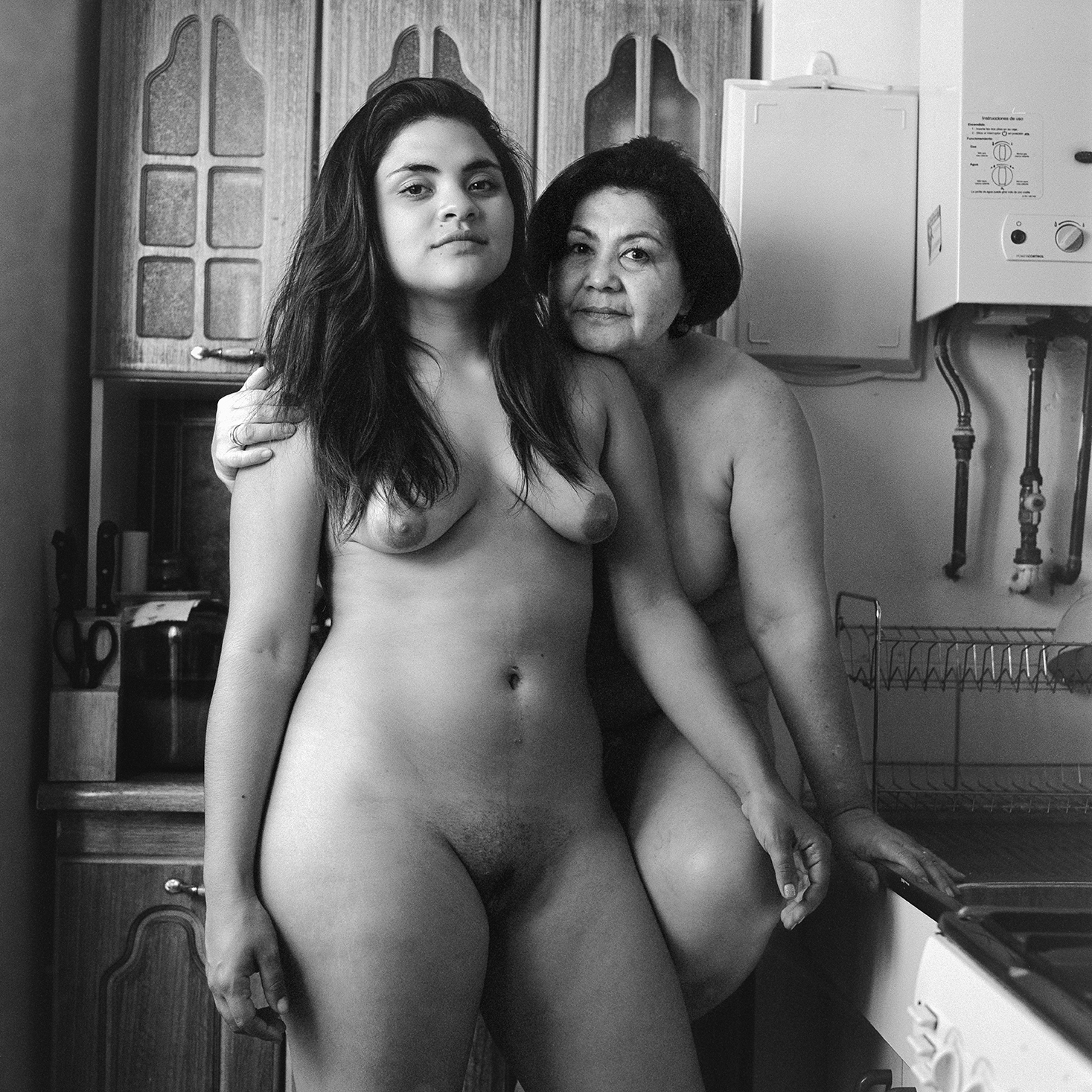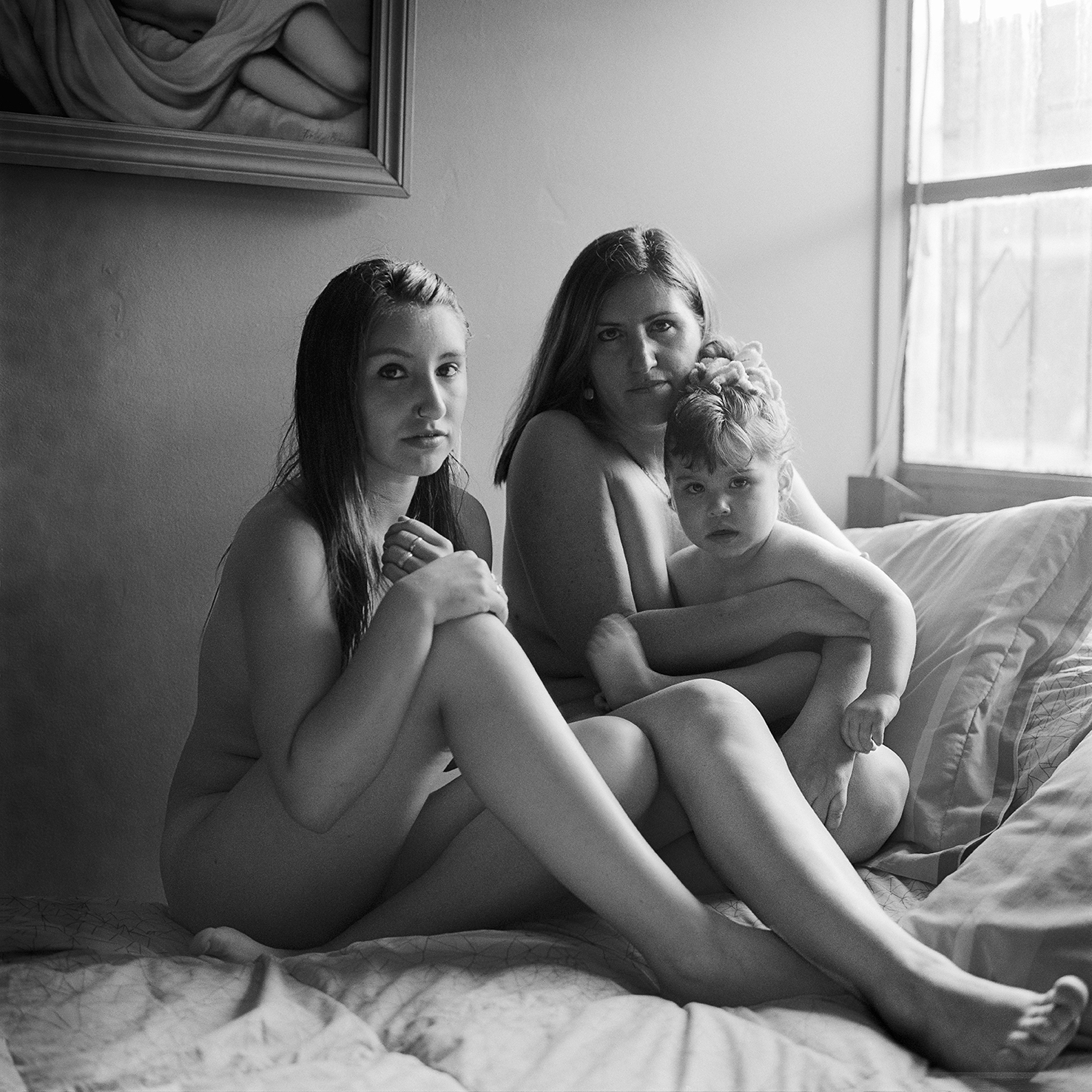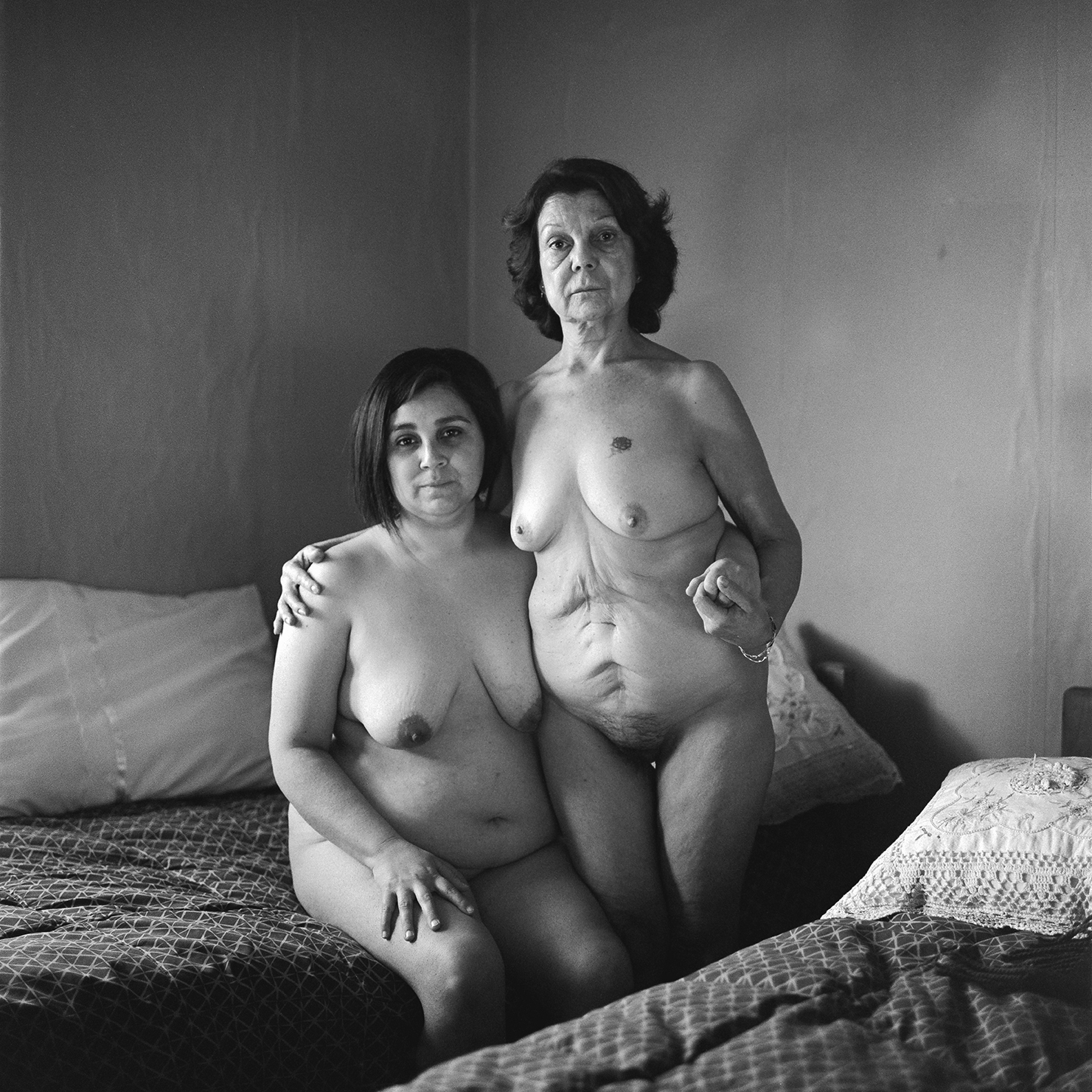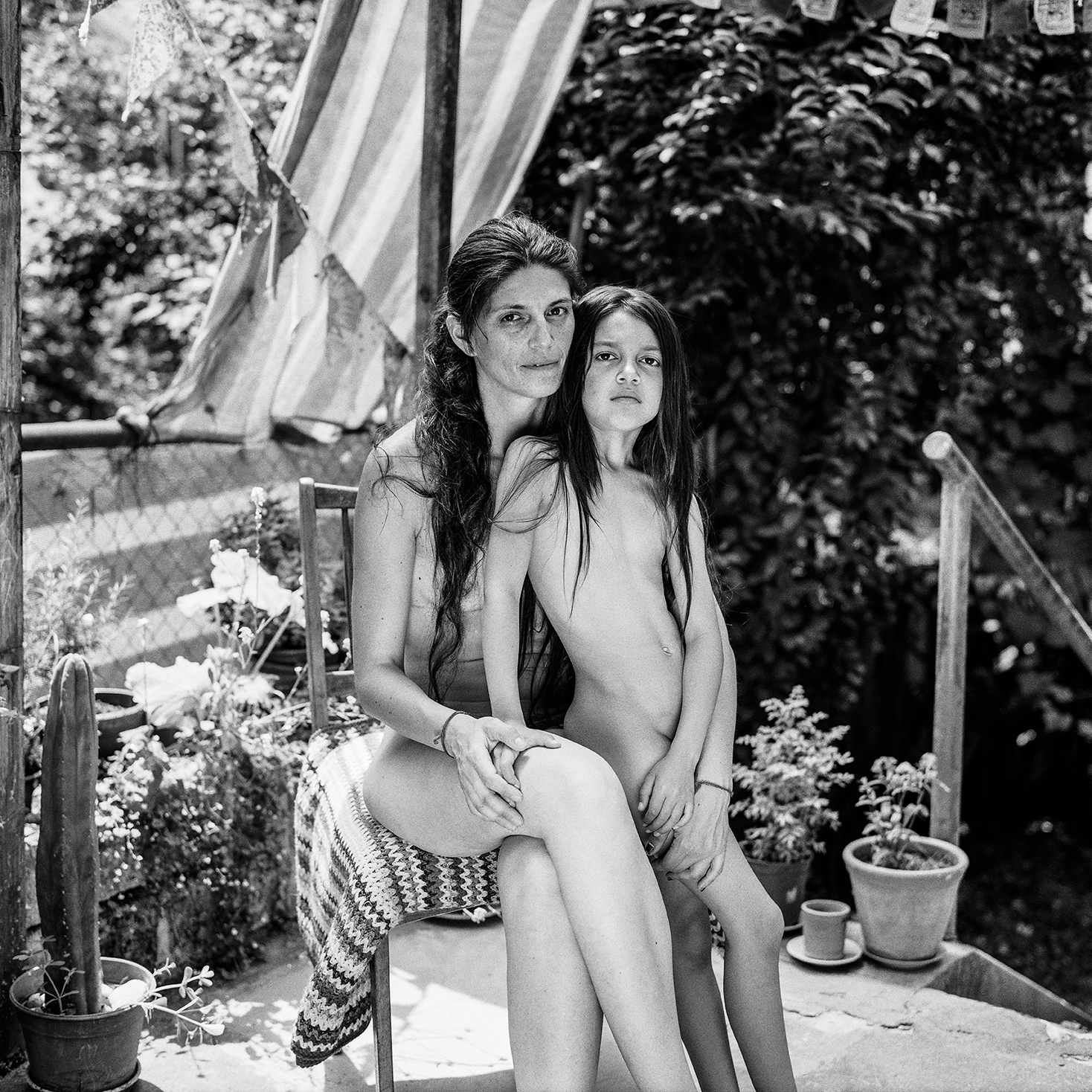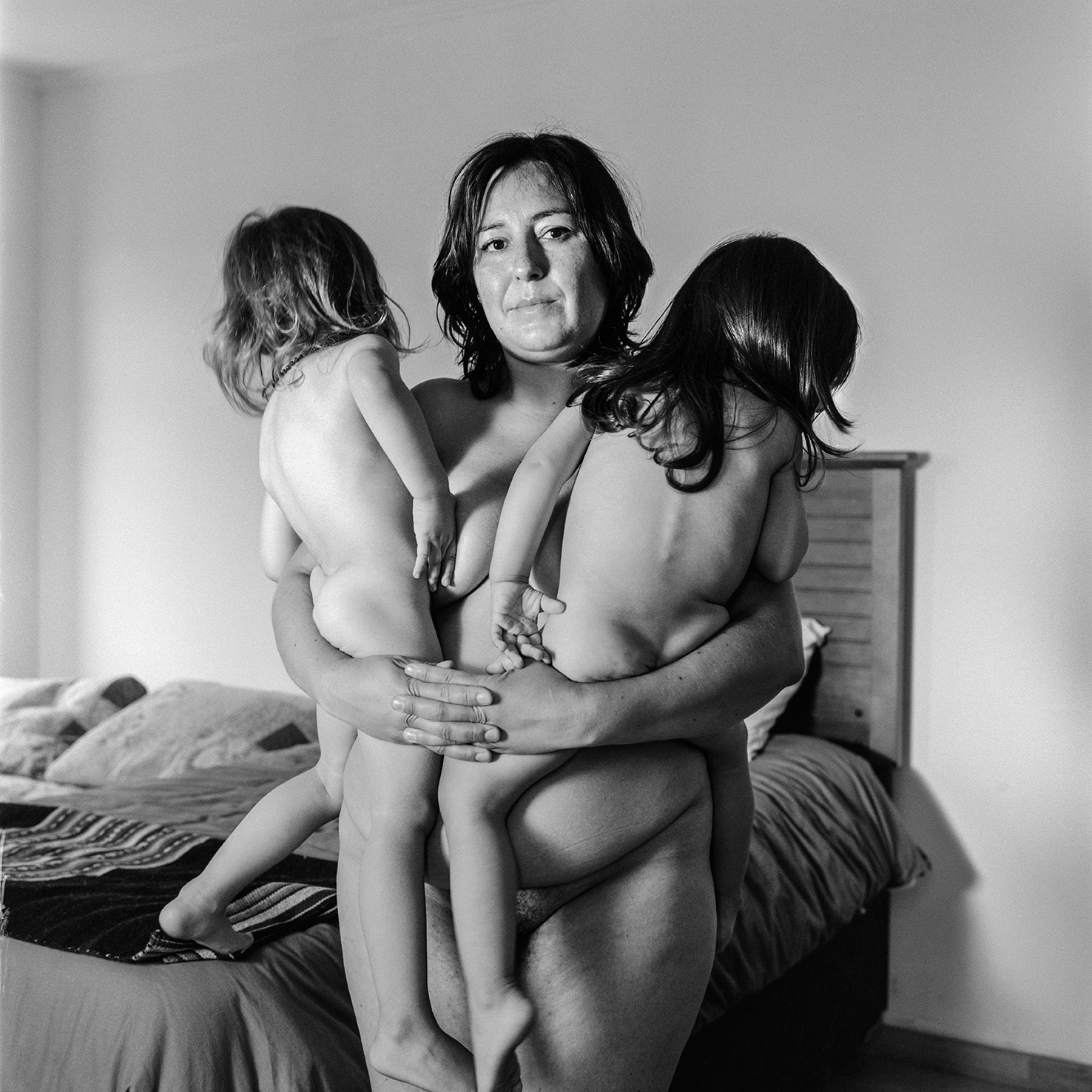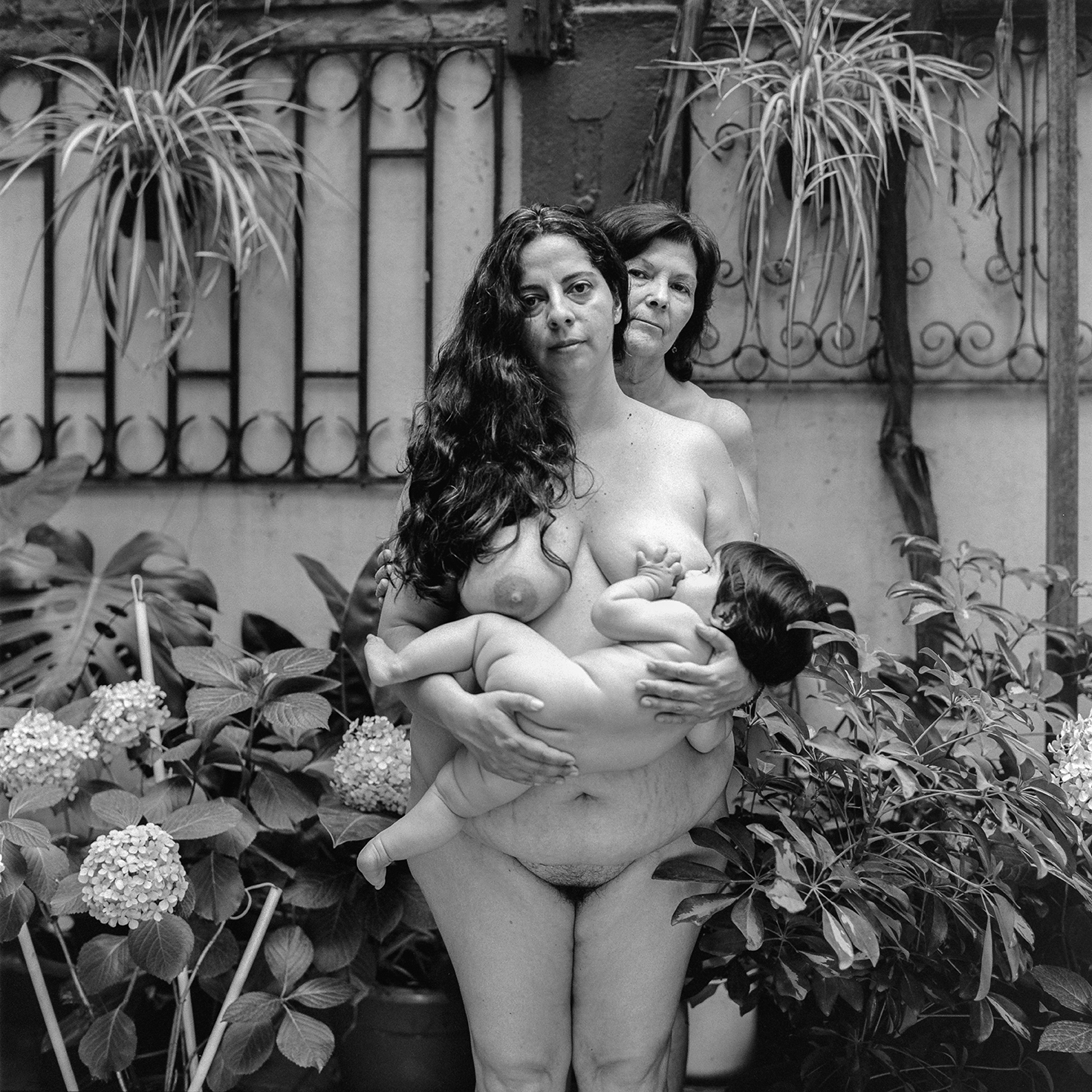La piel que nos separa
(2013-2022)La fotografía como reparadora de ausencias
Carolina Castro Jorquera
La piel que nos separa comenzó como una búsqueda personal de la autora por inmiscuirse en las relaciones entre mujeres que comparten un mismo núcleo familiar. En un comienzo, la serie tendría solo una selección de desnudos, en blanco y negro, de madres con sus hijas de diferentes edades, las que mirando directamente a la cámara revelan una cierta cercanía, una confianza implícita con quien está detrás. Sin embargo, estos primeros retratos fueron revelando una ausencia, despertando en ella la curiosidad por compartir esta experiencia con su propia madre. Fue así que, para finalizar esta serie, Catalina Juger decidió incluir algunas fotos de su álbum familiar, imágenes que dan cuenta de su necesidad de encontrar una identidad a través de la construcción y exploración de imágenes pasadas. La incorporación de este material es un ligero deslizamiento de su lugar como autora lo que, sumado al retrato de ella con su madre, la nombran objeto de su propio discurso.
Su acercamiento al retrato de madres e hijas se inscribe en una genealogía de fotógrafas que han abierto lugar a aquellos relatos de mujeres hechos por mujeres. Desde ahí que me parece importante reconocer algunas referencias que surgen al sumergirnos en esta serie que Catalina Juger comenzó en 2013. La primera es la fotógrafa argentina Adriana Lestido, con una serie realizada entre 1995-1999 que tituló Madres e hijas donde imágenes borrosas y en movimiento, y retratos de situaciones cotidianas, elaboran una multiplicidad de relatos que emergen en las relaciones entre madres e hijas desde el nacimiento hasta la edad adulta. La segunda es la fotógrafa española Ana Casas Broda con su serie Álbum, publicado en el año 2000, construido sobre el eje de la relación entre ella y su abuela, y su lazo a través de las fotos. Casas Broda reúne una serie de fotografías de su infancia tomadas por su abuela, las que a través de un fotolibro, se encuentran con las fotografías que ella misma toma de su abuela en los años previos a su muerte.
Me interesa recoger la particular cercanía que tienen estas tres series de retratos, y es que todas coinciden en mostrarnos que nuestras vidas, nuestras culturas, están hechas de diversas historias interrelacionadas, que no existe una única forma de leer esos retratos de mujeres sino que, por el contrario, cada una de estas imágenes conforman historias y sensibilidades diversas, algo que los discursos feministas contemporáneos insisten en hacernos ver. Desde cada una de ellas es posible relevar tantas presencias como ausencias, cosas evidentes y cosas no dichas, aquellas que no entran en la fotografía, pero tal vez sí estuvieron presentes en el momento en que cada una de ellas fue tomada o incluso antes, en la intimidad de cada mujer. Como una extensión de sus propias biografías, tanto Juger, Lestido y Casas Broda abren un lugar biográfico en sus series planteando en ellas sus propios vacíos.
Como un secreto que se pasa escrito en un papelito doblado por debajo de la mesa, la historia familiar de Catalina Juger se abre entre preguntas que permanecen sin ser formuladas, las que a través del retrato de estas mujeres le van otorgando el coraje suficiente para encontrarse con su madre. Como ella misma señala, “Con mi madre no tenemos una relación muy cercana, ni muy de tacto, por lo que había algo interno en mí que me pedía también incluirme en esta serie y sentir que mi experiencia como hija en el mundo estaba presente, que no era sólo una cuestión teórica, si no que nuestra presencia estaba plasmada realmente en el papel.”
En el texto introductorio de Álbum, Casas Broda se refiere a una “fe dramática en la fotografía como reparadora de ausencias”, desde donde tomé el título de este texto. Coincido en esa suerte dramática que caracteriza a la fotografía como objeto de memoria, en especial en los tiempos en que la cámara fotográfica era un dispositivo de una cierta exclusividad como seguramente lo vivieron las madres y abuelas de cada una de estas fotógrafas que aquí confluyen. En La piel que nos separa, en la sección de fotografías del álbum familiar, a continuación del retrato de la autora junto a su madre desnudas, encontramos otras veintiún fotos junto a ella, a lo largo de su infancia y adolescencia.
Al verlas, recuerdo algo que a menudo me ocurre cuando veo fotografías de mi propia infancia, cuando me sitúo en ese lugar de hija que reconstruye su infancia a través de las imágenes. Y es que los momentos que fueron fotografiados y por ende, como era propio en esos años, impresos, se confunden en mi memoria como recuerdos mucho más vívidos que otros, como si una suerte de memoria diferente se deslizara en la materialidad fotográfica que confunde los recuerdos de lo vivido con los recuerdos de lo fotografiado, o los recuerdos de mi madre con los míos. Es tal vez por eso que en la selección de fotografías de la infancia de Catalina Juger, pareciera manifestarse una suerte de nostalgia por saber más de esa madre, por comprender su lugar de hija, por preguntarle: ¿Cuánto deseaba ser madre? ¿Cómo fue su parto? ¿Hubo apego? ¿Cómo fue su puerperio, su maternidad? ¿Dejó proyectos de vida inconclusos o deseos que no pudo concretar? O quizá saber ¿Qué siente hoy y cómo se imaginaba su vida a esta edad?
Es aquí donde surge la posibilidad de pensar esta serie como una fotografía reparadora de ausencias, como una suerte de obra regenerativa que nos permite tanto completar las partes faltantes como modelar realidades posibles.
_______
Photography as a restorer of absences
Carolina Castro Jorquera
This skin between us began as a personal search of the author for interfering in the relations between women who share the same family nucleus. In the beginning, the series would have only a selection of nudes, in black and white, of mothers with their daughters of different ages, whom looking directly at the camera reveal a certain closeness, an implicit trust with who is behind. However, these first portraits were revealing an absence, arousing in her the curiosity to share this experience with her own mother. Thus, to end this series, Catalina Juger decided to include some photos from her own family album, images that show her need to find an identity through the construction and exploration of past photographs. Including this material is a slight slip of her place as an author which, added to the portrait of her and her mother, placeher as a subject of her own discourse.
Her approach to the portrait of mothers and daughters is inscribed in a genealogy of photographers who have opened the door to women stories made by women. From there it seems important to recognize some references that arise when we immerse ourselves in this series that Catalina Juger began in 2013. The first is the Argentine photographer Adriana Lestido, with a series made between 1995-1999 entitled Madres e hijas (Mothers and daughters) where blurred moving images, and portraits of everyday situations, elaborate a multiplicity of stories that emerge in the relationships between mothers and daughters from birth to adulthood. The second is the Spanish photographer Ana Casas Broda with her series Álbum (Album), published in 2000, built on the axis of the relationship between her and her grandmother, and her bond through photos. Casas Broda gathers a series of childhood photographs taken by her grandmother, which through a photobook, meet the photographs that author herself takes of her grandmother in the years before her death.
I am interested in collecting the particular closeness that these three series of portraits have.All of themcoincide in showing us that our lives, our cultures, are made of different kind of interrelated stories and there is no single way to read these portraits of women but, on the contrary, each of these images make up diverse stories and sensitivities, something that contemporary feminist discourses insist on making us see. From each one of them it is possible to relieve as many presences as absences, obvious things and things not said, those that do not enter in the photograph, but perhaps they were present at the moment when each image was captured or even before, in the privacy of every woman. As an extension of their own biographies, Juger, Lestido and Casas Broda open up a biographical place in their series by posing their own voids.
As a secret passed down on a piece of paper folded under the table, Catalina Juger’s family history opens up among questions that remain unanswered, those that through the portrait of these women, give her the courage to meet her mother. As Catalina herself points out, "With my mother, we don’t have a very close, or warm relationship, so there was something inside me that asked me to also include myself in this series, and feel that my experience as a daughter in the world was present and not just a theoretical issue, but our presence was actually reflected on paper."
In the introductory text of Álbum, Casas Broda refers to a "dramatic faith in photography as a restorer of absences", from where I took the title of this text. I agree with that dramatic fate that characterizes photography as an object of memory, especially in times when camera was a device of a certain exclusivity, as surely it was lived by the mothers and grandmothers of each of these photographers who converge here. In This skin between us, in the photographs section of the family album, following the portrait of the author with her mother naked, we find another twenty-one photos next to her, throughout her childhood and adolescence.
Seeing them, I remember something that often happens to me when I see photographs of my own childhood, when I put myself in that place of a daughter that reconstructs her childhood through images. Because those moments photographed and usually printed in those days, are confused in my memory, some of them are much more vivid than others, as if a different kind of memory slipped into the photographic materiality, that mixed up memories of what was lived with those that was photographed, or the memories of my mother with my own ones. Perhaps, that’s why in the selection of photographs of Catalina Juger’s childhood, it seems to manifest a kind of nostalgia for knowing more about that mother, for understanding her place as a daughter, for asking her: Did you want to be a mother? How was your delivery? Did you feel attachment? How was your puerperium, your motherhood? Did you leave unfinished life plans or desires that you could not realize? Or maybe to know, how do you feel today and how you imagined your life at this age?
It’s here that arises the possibility to think of this series as a restorative photography of absences, as a kind of regenerative work that allows us to complete the missing parts and to model possible realities.


